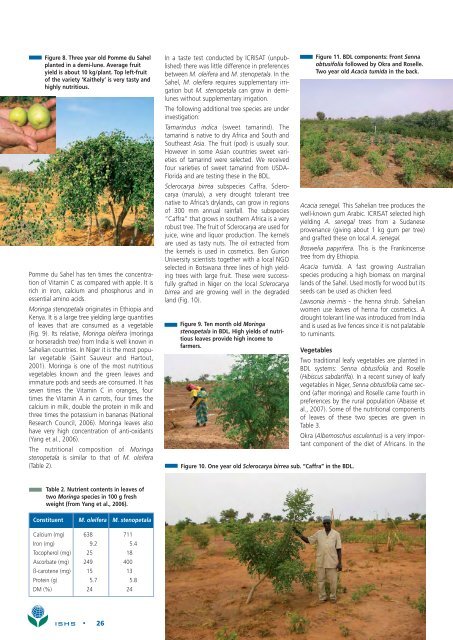Chronica Horticulturae volume 49 number 2 ... - Acta Horticulturae
Chronica Horticulturae volume 49 number 2 ... - Acta Horticulturae
Chronica Horticulturae volume 49 number 2 ... - Acta Horticulturae
You also want an ePaper? Increase the reach of your titles
YUMPU automatically turns print PDFs into web optimized ePapers that Google loves.
Figure 8. Three year old Pomme du Sahel<br />
planted in a demi-lune. Average fruit<br />
yield is about 10 kg/plant. Top left-fruit<br />
of the variety ‘Kaithely’ is very tasty and<br />
highly nutritious.<br />
Pomme du Sahel has ten times the concentration<br />
of Vitamin C as compared with apple. It is<br />
rich in iron, calcium and phosphorus and in<br />
essential amino acids.<br />
Moringa stenopetala originates in Ethiopia and<br />
Kenya. It is a large tree yielding large quantities<br />
of leaves that are consumed as a vegetable<br />
(Fig. 9). Its relative, Moringa oleifera (moringa<br />
or horseradish tree) from India is well known in<br />
Sahelian countries. In Niger it is the most popular<br />
vegetable (Saint Sauveur and Hartout,<br />
2001). Moringa is one of the most nutritious<br />
vegetables known and the green leaves and<br />
immature pods and seeds are consumed. It has<br />
seven times the Vitamin C in oranges, four<br />
times the Vitamin A in carrots, four times the<br />
calcium in milk, double the protein in milk and<br />
three times the potassium in bananas (National<br />
Research Council, 2006). Moringa leaves also<br />
have very high concentration of anti-oxidants<br />
(Yang et al., 2006).<br />
The nutritional composition of Moringa<br />
stenopetala is similar to that of M. oleifera<br />
(Table 2).<br />
In a taste test conducted by ICRISAT (unpublished)<br />
there was little difference in preferences<br />
between M. oleifera and M. stenopetala. In the<br />
Sahel, M. oleifera requires supplementary irrigation<br />
but M. stenopetala can grow in demilunes<br />
without supplementary irrigation.<br />
The following additional tree species are under<br />
investigation:<br />
Tamarindus indica (sweet tamarind). The<br />
tamarind is native to dry Africa and South and<br />
Southeast Asia. The fruit (pod) is usually sour.<br />
However in some Asian countries sweet varieties<br />
of tamarind were selected. We received<br />
four varieties of sweet tamarind from USDA-<br />
Florida and are testing these in the BDL.<br />
Sclerocarya birrea subspecies Caffra. Sclerocarya<br />
(marula), a very drought tolerant tree<br />
native to Africa’s drylands, can grow in regions<br />
of 300 mm annual rainfall. The subspecies<br />
“Caffra” that grows in southern Africa is a very<br />
robust tree. The fruit of Sclerocarya are used for<br />
juice, wine and liquor production. The kernels<br />
are used as tasty nuts. The oil extracted from<br />
the kernels is used in cosmetics. Ben Gurion<br />
University scientists together with a local NGO<br />
selected in Botswana three lines of high yielding<br />
trees with large fruit. These were successfully<br />
grafted in Niger on the local Sclerocarya<br />
birrea and are growing well in the degraded<br />
land (Fig. 10).<br />
Figure 9. Ten month old Moringa<br />
stenopetala in BDL. High yields of nutritious<br />
leaves provide high income to<br />
farmers.<br />
Figure 10. One year old Sclerocarya birrea sub. “Caffra” in the BDL.<br />
Figure 11. BDL components: Front Senna<br />
obtusifolia followed by Okra and Roselle.<br />
Two year old Acacia tumida in the back.<br />
Acacia senegal. This Sahelian tree produces the<br />
well-known gum Arabic. ICRISAT selected high<br />
yielding A. senegal trees from a Sudanese<br />
provenance (giving about 1 kg gum per tree)<br />
and grafted these on local A. senegal.<br />
Boswelia papyrifera. This is the Frankincense<br />
tree from dry Ethiopia.<br />
Acacia tumida. A fast growing Australian<br />
species producing a high biomass on marginal<br />
lands of the Sahel. Used mostly for wood but its<br />
seeds can be used as chicken feed.<br />
Lawsonia inermis - the henna shrub. Sahelian<br />
women use leaves of henna for cosmetics. A<br />
drought tolerant line was introduced from India<br />
and is used as live fences since it is not palatable<br />
to ruminants.<br />
Vegetables<br />
Two traditional leafy vegetables are planted in<br />
BDL systems: Senna obtusifolia and Roselle<br />
(Hibiscus sabdariffa). In a recent survey of leafy<br />
vegetables in Niger, Senna obtusifolia came second<br />
(after moringa) and Roselle came fourth in<br />
preferences by the rural population (Abasse et<br />
al., 2007). Some of the nutritional components<br />
of leaves of these two species are given in<br />
Table 3.<br />
Okra (Albemoschus esculentus) is a very important<br />
component of the diet of Africans. In the<br />
Table 2. Nutrient contents in leaves of<br />
two Moringa species in 100 g fresh<br />
weight (from Yang et al., 2006).<br />
Constituent M. oleifera M. stenopetala<br />
Calcium (mg) 638 711<br />
Iron (mg) 9.2 5.4<br />
Tocopherol (mg) 25 18<br />
Ascorbate (mg) 2<strong>49</strong> 400<br />
ß-carotene (mg) 15 13<br />
Protein (g) 5.7 5.8<br />
DM (%) 24 24<br />
ISHS • 26
















